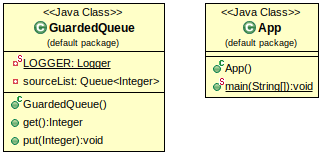Guarded Suspension
Intent
Use Guarded suspension pattern to handle a situation when you want to execute a method on object which is not in a proper state.
Class diagram

Applicability
Use Guarded Suspension pattern when the developer knows that the method execution will be blocked for a finite period of time
Explanation
Real world example
When we reserve a dining room online and arrive to find it unready, the manager has it cleaned while we wait.
Once ready, we're escorted to the room. This process exemplifies the Guarded Suspension pattern.
In plain words
Guarded Suspension pattern is used when one thread waits for the result of another thread's execution.
Wikipedia says
In concurrent programming, Guarded Suspension manages operations requiring a lock
and a precondition, delaying execution until the precondition is met.
Programmatic Example
The GuardedQueue class encapsulates a queue, and provides two synchronized methods, get and put.
The get method waits if the queue is empty, and the put method adds an item to the queue and notifies waiting threads:
public class GuardedQueue {
private final Queue<Integer> sourceList = new LinkedList<>();
public synchronized Integer get() {
while (sourceList.isEmpty()) {
try {
wait();
} catch (InterruptedException e) {
e.printStackTrace();
}
}
return sourceList.peek();
}
public synchronized void put(Integer e) {
sourceList.add(e);
notify();
}
}
public class App {
public static void main(String[] args) {
GuardedQueue guardedQueue = new GuardedQueue();
ExecutorService executorService = Executors.newFixedThreadPool(3);
// Here we create the first thread which is supposed to get from guardedQueue
executorService.execute(guardedQueue::get);
try {
Thread.sleep(2000);
} catch (InterruptedException e) {
e.printStackTrace();
}
// Here we create the second thread which is supposed to put to guardedQueue
executorService.execute(() -> {
guardedQueue.put(20);
});
executorService.shutdown();
try {
executorService.awaitTermination(30, TimeUnit.SECONDS);
} catch (InterruptedException e) {
e.printStackTrace();
}
}
}
Related patterns
- Balking